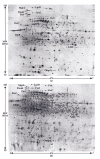Transposon Insertion in the purL Gene Induces Biofilm Depletion in Escherichia coli ATCC 25922
- PMID: 32971800
- PMCID: PMC7558270
- DOI: 10.3390/pathogens9090774
Transposon Insertion in the purL Gene Induces Biofilm Depletion in Escherichia coli ATCC 25922
Abstract
Current Escherichia coli antibiofilm treatments comprise a combination of antibiotics commonly used against planktonic cells, leading to treatment failure. A better understanding of the genes involved in biofilm formation could facilitate the development of efficient and specific new antibiofilm treatments. A total of 2578 E. coli mutants were generated by transposon insertion, of which 536 were analysed in this study. After sequencing, Tn263 mutant, classified as low biofilm-former (LF) compared to the wild-type (wt) strain (ATCC 25922), showed an interruption in the purL gene, involved in the de novo purine biosynthesis pathway. To elucidate the role of purL in biofilm formation, a knockout was generated showing reduced production of curli fibres, leading to an impaired biofilm formation. These conditions were restored by complementation of the strain or addition of exogenous inosine. Proteomic and transcriptional analyses were performed to characterise the differences caused by purL alterations. Thirteen proteins were altered compared to wt. The corresponding genes were analysed by qRT-PCR not only in the Tn263 and wt, but also in clinical strains with different biofilm activity. Overall, this study suggests that purL is essential for biofilm formation in E. coli and can be considered as a potential antibiofilm target.
Keywords: E. coli; biofilm; curli fibers; purL; transposon insertion.
Conflict of interest statement
The authors declare no conflict of interest.
Figures









